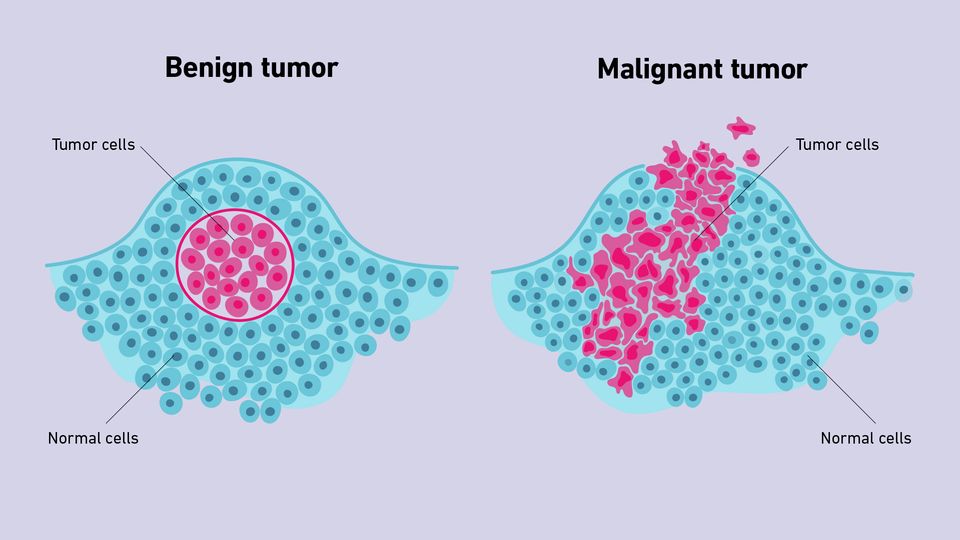A term for diseases in which abnormal cells divide without control and can invade nearby tissues. Malignant cells can also spread to other parts of the body through the blood and lymph systems. There are several main types of malignancy. Carcinoma is a malignancy that begins in the skin or in tissues that line or cover internal organs. Sarcoma is a malignancy that begins in bone, cartilage, fat, muscle, blood vessels, or other connective or supportive tissue. Leukemia is a malignancy that begins in blood-forming tissue, such as the bone marrow, and causes too many abnormal blood cells to be made. Lymphoma and multiple myeloma are malignancies that begin in the cells of the immune system. Central nervous system cancers are malignancies that begin in the tissues of the brain and spinal cord. Also called cancer.
Is Malignancy a cancer?
Malignancy, also known as cancer, is a complex and multifaceted disease that affects millions of people worldwide. It is characterized by the uncontrolled growth and spread of abnormal cells within the body, which can ultimately lead to tissue damage, organ failure, and even death.
The development of malignancy is a gradual process that can take years or even decades to manifest. The initial stages of cancer involve the accumulation of mutations in the DNA of cells, which can disrupt normal cellular processes and lead to uncontrolled growth.
As cancer cells continue to proliferate, they can invade nearby tissues and organs, disrupt the body’s normal functions, and even metastasize to other parts of the body through the bloodstream or lymphatic system.
There are many different types of malignancies, each with its own unique set of characteristics and treatment options. Some of the most common types of cancer include breast cancer, lung cancer, prostate cancer, and colon cancer.
While the causes of malignancy are not entirely understood, there are several risk factors that have been identified. These include exposure to certain chemicals and toxins, smoking, excessive alcohol consumption, a family history of cancer, and genetic mutations.
Diagnosis of malignancy typically involves a variety of tests and procedures, including imaging scans, biopsies, and blood tests. Once a diagnosis has been made, treatment options will vary depending on the type and stage of the cancer, as well as the patient’s overall health and preferences.
Some common treatment options for malignancy include surgery, chemotherapy, radiation therapy, immunotherapy, and targeted therapy. In many cases, a combination of these approaches may be used to achieve the best possible outcome.
Despite significant advances in the diagnosis and treatment of malignancy, it remains a major public health challenge around the world. Each year, millions of people are diagnosed with cancer, and many of them will ultimately succumb to the disease.
In order to better understand and combat malignancy, significant research efforts are currently underway. These efforts are focused on identifying new risk factors, developing more effective treatment options, and improving our overall understanding of the disease.
Some promising areas of research include the use of precision medicine, which involves tailoring treatment options to the specific genetic characteristics of individual patients. Additionally, efforts are underway to develop new immunotherapies that can harness the power of the immune system to target and eliminate cancer cells.
While the battle against malignancy is far from over, there is reason for hope. With continued research and innovation, we may one day be able to effectively prevent, diagnose, and treat this devastating disease.
Can Cancer Be Cured?
Whether a person’s cancer can be cured depends on the type and stage of the cancer, the type of treatment they can get, and other factors. Some cancers are more likely to be cured than others. But each cancer needs to be treated differently. There isn’t one cure for cancer.
Cure versus remission
A cure means that the cancer has gone away with treatment, no more treatment is needed, and the cancer is not expected to come back. It’s rare that a doctor can be sure that cancer will never come back. In most cases it takes time to know if the cancer might come back. But, the longer a person is cancer free, the better the chance that the cancer will not come back. More often, when treatment appears to be successful, doctors will say the cancer is “in remission,” rather than “cured.”
Remission is a period of time when the cancer is responding to treatment or is under control. Some people think that remission means the cancer has been cured, but that may not be the case.
- In a complete remission, all the signs and symptoms of cancer go away, and cancer cells can’t be found by any tests.
- In a partial remission, the cancer shrinks but doesn’t completely go away.
Remissions can last anywhere from weeks to years. Treatment may or may not continue during a remission, depending on the type of cancer. Complete remissions may go on for years and, over time, the cancer may be thought to be cured. If the cancer returns (recurrence), another remission may be possible with more treatment.
What do survival statistics mean?
When told they have cancer, many people ask their doctor what their chance of survival is. While there are many factors that go into an answer, there are statistics that may help. Statistics are numbers that describe what happens to large groups of people with the same diagnosis. Statistics cannot be applied to a specific person but may give some idea of what to expect.
Here are some statistics that are used for cancer:
- Survival rate: the percentage of people who are alive at a certain time after diagnosis.
- Overall survival rate: the percentage of people with a certain type and stage of cancer who have not died from any cause during a period of time after diagnosis.
- Cancer (or disease)-specific survival rate: the percentage of people with a certain type and stage of cancer who have not died from their cancer during a set period of time after diagnosis.
- 5-year relative survival rate: the percentage of people who will be alive 5 years after diagnosis. It does not include those who die from other diseases.
Survival rates can describe any length of time. However, researchers usually look at 5-year relative survival rates.
What does it mean to be a cancer survivor?
There is more than one definition of cancer survivor. Some people use this term to refer to anyone who has ever been diagnosed with cancer. This is what the American Cancer Society means when we talk about survivorship or living as a cancer survivor.
But some people use the term “survivor” for someone who has completed cancer treatment. And still others might only call a person a survivor if they have lived several years past a cancer diagnosis. Remember though, that treatment lasts longer for some people, and not everyone completes treatment. Some people may live for many years with cancer as a chronic disease.
Others who are impacted, like family and friends, might also sometimes be considered cancer survivors.
Being a cancer survivor means different things for different people. Some people will be cancer free after treatment but may experience late and long term side effects of treatment. Others may be cancer free after treatment but have their cancer come back and need to be treated again. Still others will need to continue with cancer treatment to keep their cancer under control. But anyone who has been diagnosed with cancer needs care that focuses on their unique needs.
Not everyone likes to be called a cancer survivor. Each person has the right to define their experience with cancer. So, anyone who describes themselves as a cancer survivor should be considered one.
 Lifeyet News Lifeyet News
Lifeyet News Lifeyet News





